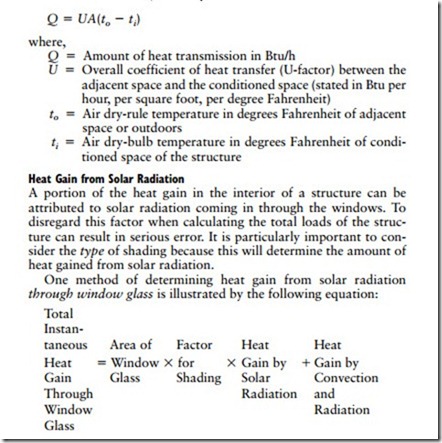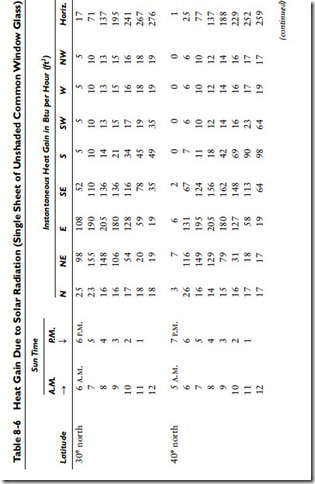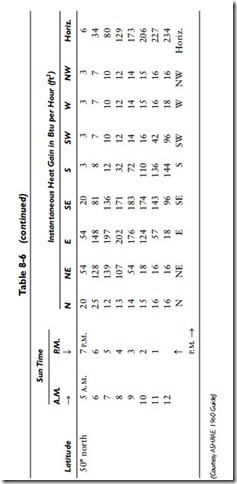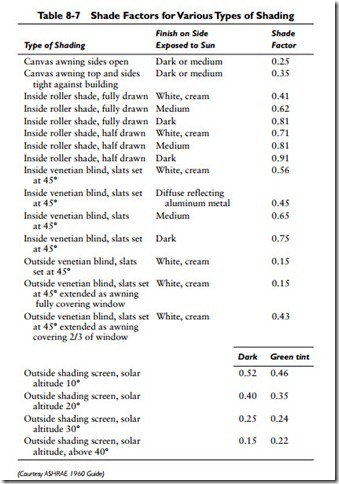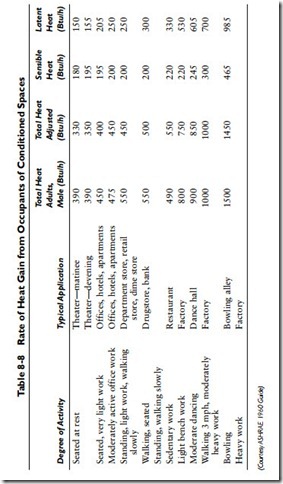Cooling a Structure
The aspect of air-conditioning most familiar to us is the reduction of indoor temperatures to a comfortable level. There are a number of different sources of indoor heat, some are external and some are internal.
External Sources of Heat
The principal sources of heat from outside the structure are solar radiation, heat leakage, infiltration, and ventilation.
Heat Leakage
Heat leakage refers to the amount of heat flow through structural sections and is stated in Btu per hour, per degree Fahrenheit, per square foot of exposed surface. A significant portion of the total heat gain of a space is due to heat from the outside of a structure or from a nonconditioned space passing (that is, leaking) through walls, ceilings, floors, and roofs to the interior of the structure.
The coefficient of heat transmission (U-factor) is the specific value used in determining the amount of heat leakage. It has already been described in Chapter 4 (“Heating Calculations”) in Volume 1 in the section Heat Loss. Actually the only difference between heat leakage and heat loss is the direction of heat flow. Both are concerned with the same thermal properties of construction materials and the rate at which heat flows through them. Insofar as heat leakage is concerned, the direction of heat flow is from the outside to the inside of the structure. In the case of heat loss, the reverse is true.
The formula used for calculating heat leakage is identical to the one used for heat loss, and may be stated as follows:
taneous Area of Factor Heat Heat Heat = Window X for X Gain by + Gain by The ASHRAE has conducted extensive research into all aspects of solar radiation, and makes the results of this research available through its publications. As you saw earlier, Tables 8-3 and 8-4 were adapted by permission from the ASHRAE 1960 Guide to illustrate the aforementioned equation for determining total instantaneous heat gain through window glass.
Calculating the amount of heat gain due to solar radiation through a glass window can be even more clearly illustrated by using the above equation to solve a problem. Let us assume that you have a residence containing four 3′ × 4′ windows facing south. The structure is located 30° north, and complete exposure to the sun occurs at 1:00 P.M. The indoor temperature is 80°F. The windows are shaded by dark brown canvas awnings that are open at the sides. As you will note by looking carefully at Tables 8-6 and 8-7, each of these points in the description of the structure is important in the solution. The total instantaneous heat gain through these windows can be determined as follows:
1. Window glass area = 3′ × 4’= 12 square feet
2. Factor for shading = 0.25
3. Heat gain by solar radiation = 45 Btu/h per square foot
4. Heat gain by convection and radiation = 17 Btu/h per square foot
Total instantaneous heat gain through the four windows can be found as follows:
12 X (0.25 X 45 + 17)
12 X 28.25
339 Btu/h (for one window) X 4 windows 1356 Btu/h
In Table 8-7, note that the shading factors are given not only for such items as shading screens and awnings located on the outside of the structure but also for window shades, venetian blinds, and draperies located on the inside. It is always recommended that windows of air-conditioned spaces be shaded in some manner.
Heat Gain from Infiltration and Ventilation
A certain amount of warm outdoor air will enter the interior of a
structure by means of infiltration and ventilation. Both phenomena are described in considerable detail in Chapter 6 (“Ventilation
Principles”) and in the section Ventilation Standards in this chapter. These materials should be read before proceeding any further.
Insofar as cooling load calculations are concerned, infiltration (that is, natural ventilation) is the leakage of warmer outdoor air into the interior of a structure usually as the result of wind pressure. This occurs primarily through cracks around windows and doors. As a result, the crack method is considered the most accurate means of calculating heat leakage by air infiltration (see the appropriate section of Chapter 4 in Volume 1 (“Heating Calculations”). A rule- of-thumb method for calculating heat leakage around doors located in exterior walls is to allow twice the window heat leakage.
Some authorities feel that infiltration will fulfill the ventilation requirements of small structures (for example, houses, offices, and small shops) and that no special provisions need be made for a mechanical ventilating system. Unfortunately, there is little or no infiltration on days during which the outdoor air is perfectly still.
The amount of ventilation is generally determined by the num- ber of air changes (inside air replaced by air from the outdoors) required by a structure. This is most commonly based on the num- ber of occupants and building use. In structures having air-condi- tioning, most of the outdoor air used for ventilation will pass through the air-conditioning unit. A small portion of the air will bypass the air-conditioning coils and add to the sensible and latent heat levels of the interior spaces of the structure. The temperature and humidity of the air that does pass over the cooling coils of the unit are reduced to room conditions or below.
Internal Sources of Heat
A number of heat sources within a structure contribute to heat gain
independently from outside sources. The most important internal heat gain sources are the following:
1. People
2. Electric lighting
3. Appliances
4. Electric motors
5. Steam
The occupants of conditioned spaces give off both sensible and latent heat. The amount of heat gain will depend on a number of variables, including (1) the duration of occupancy, (2) the number of people, and (3) their principal activity. Table 8-8 lists estimated heat gains from a variety of activities performed by individuals.
